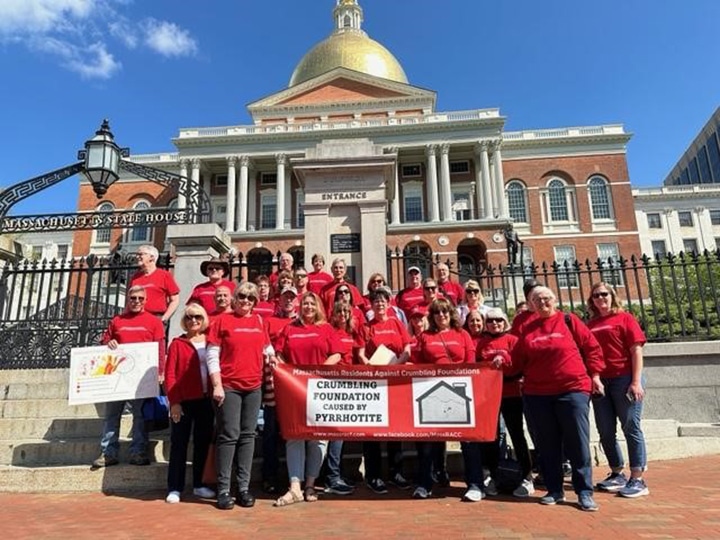A group from The Massachusetts Residents Against Crumbling Foundations, met with officials at the State House on May 13. MRACF is an advocacy group made of homeowners from across the state who seek to raise awareness and work with lawmakers to pass legislation regarding issues concerning the construction of their homes and others like them.
Reminder Publishing submitted photo
MONSON — A May 13 bus trip to the Massachusetts State House included local community members, part of the Massachusetts Residents Against Crumbling Foundations, an advocacy group made of homeowners from across the state who seek to raise awareness and work with lawmakers to pass legislation regarding issues concerning the construction of their homes and others like them.
The specific concern is the presence of pyrrhotite, a mineral present and said to be contaminating the concrete used in the foundations of their houses during construction. Members of MRACF are hoping for financial assistance, achieved through legislation, for homeowners who have been affected by crumbling concrete in their home’s foundations and the impact they have been experiencing as a result.
Monson resident Michelle Loglisci, the group organizer and a homeowner, said it was in 2017 when she became aware of a Longmeadow resident experiencing crumbling foundation issues at his house. Loglisci came to learn that the concrete source used in her own home came from the same provider. Alarmed by the association, Loglisci said she quickly looked at her homeowner’s insurance policy and discovered the foundation was not covered.
She also came to discover that like homeowners with similar issues, despite the fact that she and her husband had paid off the home, because of the developing damage to the foundation, there was no equity value to the dwelling.
Legal actions against the Connecticut-based company that provided the concrete materials had failed because the company had gone out of business, as did action against the quarry from which those materials originated.
Since the initial discoveries of the foundation vulnerabilities and the attribution to the pyrrhotite contained in the stone, mixed as part of the concrete, issues have been identified in many parts of the states as well as communities in Springfield, Hampden and East Longmeadow.
“We’ve had geologists explain it to us at meetings,” Loglisci said. “[Pyrrhotite] cracks the concrete and once water and oxygen get in, it keeps going and gets worse.”
She said some foundations are so bad that the total structure of the house is threatened, which creates major challenges for the homeowners no matter their age or how much time they’ve lived in their homes. Those challenges specifically, how to pay for repairs.
“Some people have had to find a way to finance this,” She said. “A large part of the group are older people who are getting ready to use their retirement funds but now have to use it to replace their foundation and then they can’t retire.”
Loglisci said it was 2018 when she began contacting people in communities near and far to compare stories and experiences with the issues they all had in common. She also reached out to state Rep. Brian Ashe (D-Longmeadow) who said at the time that his office was becoming aware of the growing problem.
MRACF was formed shortly after that with the intent to identify more affected communities and make more legislators aware. When homeowners were found in Holden with the same problems, it was discovered that a company there used the same concrete in a major portion of their homebuilding operations in Holden and Rutland, that concrete coming from the same quarry that produced the earlier suspect materials. A company in Charlton was also found to be another source of the materials containing pyrrhotite and Loglisci said houses as far north as the New Hampshire border, in the town of Winchendon and as far east as Mendon were constructed with the affected concrete. Thirty-eight cities and towns have been identified at present.
“Since 2018, we have been advocating for legislation, “ she said. A commission was created to study the issues and the economic impact followed by a reimbursement program for the studies and inspections, which have been part of annual budgets for four years. An assistance program pursuit failed as have efforts for legislation to assist the homeowners.
“We do have hope,” Loglisci said.” We have an expectation that both the House and Senate will have an amendment proposed by Rep. Ashe to the governor’s Affordable Homes Act. That amendment would charge the Insurance Commission with determining the best route to go, either Massachusetts creating its own agency to run a foundation replacement program or joining the one that exists in Connecticut.”
Regulations are also being sought to prevent the sale and use of concrete mix containing pyrrhotite, something Loglisci said is still happening at present.
At the May 13 State House meeting, MRACF met with staff from Gov. Maura Healey’s office and from state Senate Chair of Ways and Means Michael Rodrigues’ (D-Westport) office to discuss potential solutions and emphasize the need for state support.
Ashe called the impact on homeowners, “devastating”.
“The state needs to step in to assist these homeowners as the high cost of replacing the foundation is not covered by insurance and banks will not provide loans due to the decreased value of their home,” He said.” I commend the members of the Massachusetts Residents Against Crumbling Foundations for continuing to advocate on behalf of all affected homeowners and I will continue to work with my colleagues in the House and the Senate on getting a program in place to assist homeowners.”
The impact on Loglisci and homeowners like her continues, she said.
Loglisci said over the last seven years she has met homeowners with serious events and problems going on in their lives that they cannot manage simply because they are unable to sell their homes.
“My life has been on hold for 6½ [years] now,” Loglisci said. “I can’t sell my house. My son and his wife wanted to buy the house and raise their kids here and we wanted to downsize. But they can’t buy the house because they can’t get a mortgage for a house with a crumbling foundation. My grandchildren, meanwhile, are getting older and by the time we get this done they’re not going to need a bigger house. And that’s only my story.”
Meanwhile MRACF presents forums in communities experiencing the effects of the foundation deterioration as well as visits with legislators whose districts are or are not impacted, all in hopes of raising the awareness and potential for decades of future problems.
More information can be found on MRACF’s Facebook page or at massracf.com.


